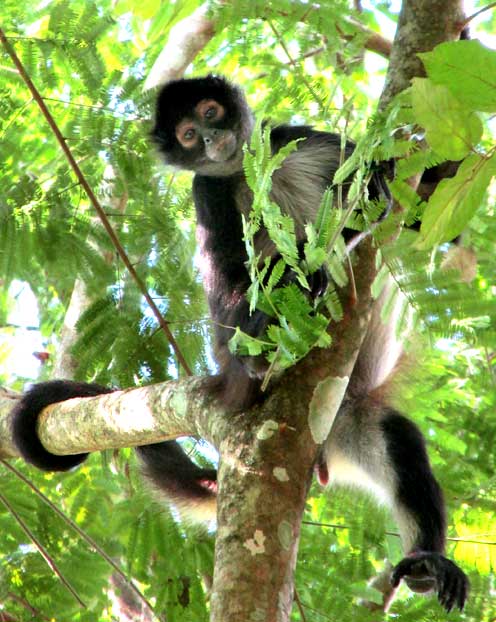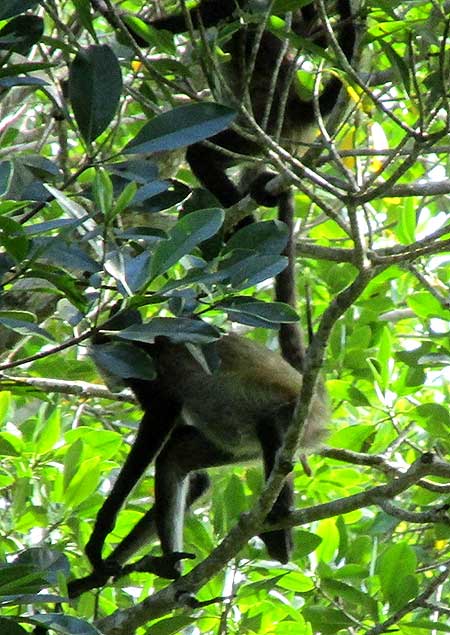Excerpts from Jim Conrad's
Naturalist Newsletter
from the October 16, 2016 Newsletter with notes taken in Frontera Corozal, Chiapas, Mexico, on the Usumacinta River where it forms the border between Mexico and Guatemala
SPIDER MONKEYS IN FRONTERA COROZAL
On October 5th when I was in Frontera Corozal, Chiapas, on Mexico's southern border with Guatemala, getting a new visa for Mexico, one afternoon as I lay in my tent a tremendous roaring erupted in the trees above me. It was a Howler Monkey calling, but when I looked around, I saw Spider Monkeys. One spider monkey who paused above my tent that afternoon is shown below:

And, below, that one's hard-to-interpret "grin" can be wondered at

This is Geoffroy's Spider Monkey, ATELES GEOFFROYI. In general, species of the genus Ateles are among the smartest of primates. A 2007 study found that only humans, orangutans and chimpanzees are smarter. It's suggested that the spider monkey's acute intelligence may have arisen because of their fruit-eating, or "frugivorous," diet, which requires them to identify and memorize many fruit types, and to remember the fruits' locations.
Despite their intelligence, spider monkeys don't make tools. That coincides with the fact that their hands bear only vestigial thumbs, thumbs being handy for handling tools. This near-thumblessness is a feature of the entire genus Ateles, the name Ateles meaning "imperfect," referring to the hands lacking decent thumbs.
At my campsite in Frontera Corozal when I first noticed the spider monkeys because of a roaring howler monkey, there wasn't a chance that I was confusing the calls of the species, because spider monkeys simply don't roar. They're described as producing barks, whinnies, squeals, squeaks and screams, but no roars. During my stay among them I never heard any of their vocalizations, just the rustling of leaves as they moved among tree branches above the tent.
Monkeys also communicate with body language, so I tried to look up what the "grin" in our photo might have meant. I found nothing about that, but I did learn that Geoffroy's Spider Monkeys curl their tails or arch their backs in order to threaten. If one shakes its head, either it's a threat or an invitation to play. If the species shakes tree branches or sways its arms about, that's a warning of danger to the group
from the January 11, 2015 Newsletter issued from Río Lagartos, on the Yucatan Peninsula's northern coast (~N21.60°, ~W88.16°), Yucatán state, MÉXICO
SPIDER MONKEYS
It all happened too quickly. On a trail deep inside the mangroves we passed beneath an Amate, a strangler fig tree, beneath which many green, immature, fruits littered the forest floor. Why were those immature fruits on the ground and not ripening on the tree? Diego looked around, trying to understand, and saw the reason: They'd been dropped there by spider monkeys, and at that very moment the monkeys were swinging through the treetops escaping. Following Diego, I reeled around and snapped the poorly framed picture appearing below:

When a human sees wild monkeys being themselves, there's a certain flash of recognition of common roots: The monkey turning its head for one last look at you before disappearing into seclusion; the wrists and knees angling in a certain familiar way; the curve of a flexible spine just right for multitasking; the all-too-familiar pot belly. Other animals with their rigid exoskeletons and with eyes on the sides of their heads and elsewhere can't arouse such empathy as I felt at that moment.
Back in the 70s and 80s I used to see spider monkeys regularly in the vast lowland forests of Chiapas and northern Guatemala, but now those forests are mostly gone, converted into weedy cornfields and ranchland. Once northern Yucatan's forests also hosted Howler Monkeys, whose roars send a chill through you on foggy mornings, but now that species is extirpated even here. Seeing these Spider Monkeys that somehow have held on here was very good.
Spider Monkeys, sometimes more formally named Geoffroy's Spider Monkeys or Black-handed Spider Monkeys, are ATELES GEOFFROYI, and they occur from southern Mexico south through Central America and possibly into a small part of Colombia. Some primatologists regard the Black-headed Spider Monkey of Panama, Colombia and Ecuador as the same species and if that's so then the species extends a bit more into northern South America. Usually seven subspecies of Geoffroy's Spider Monkey are recognized. Ours is Ateles geoffroyi ssp. yucatanensis, present in the Yucatan Peninsula, northeastern Guatemala, and adjoining parts of Belize.
Though when swinging through the trees spider monkeys seem light and agile, they're one of the largest of all New World monkeys, weighing up to 20lbs (9kgs). Still, their long tails are strong enough to support their entire weight when they dangle from a limb. In our picture you can see that their arms are longer than their legs. Their hands bear only a vestigial thumb, but their strong fingers are long and hook-like.
Geoffroy's Spider Monkeys are known to spend 70 to 80% of their feeding time eating ripe, fleshy fruit, such as figs. I'm guessing that the unripe figs beneath the strangler had been picked, tested, and found to be too hard to eat. The species also eats young leaves, which provide protein lacking in many fruits, and flowers, bark, insects, honey, seeds and buds. Water needs are largely met by the juice in the fruits they eat, but also they drink from tree holes and from what collects at the base of certain bromeliads up in the trees. Sometimes they descend to the ground to drink
The IUCN Red List of Threatened Species regards Geoffroy's Spider Monkey as an endangered species, stating that "... habitat loss across its range has been severe such that it is estimated that the species has declined by as much as 50% over the course of the past 45 years (three generations)."
Think of the impact on human society if grandparents had to tell their grandkids that during their lifetime half of all people on Earth had disappeared.
Recent studies using mitochondrial DNA indicate that spider monkeys branched off from woolly monkeys and muriquis about 3.6 million years ago. On the Phylogenetic Tree of Life, New World monkeys as a whole diverged from the branch on which Old World chimpanzees, humans, gorillas, orangutans, gibbons and Old World monkeys continued to evolve and diverge about 32 million years ago. Humans separated from chimpanzees only about five to seven million years ago.